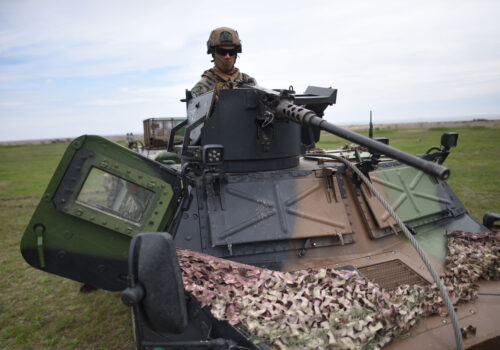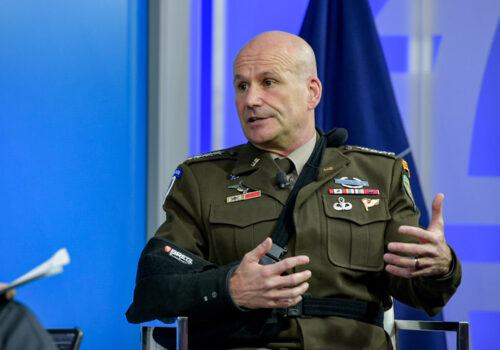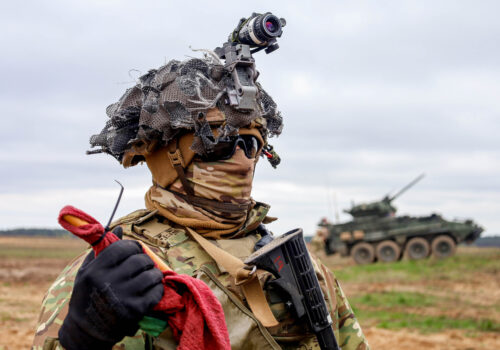Why NATO matters
The 2024 US presidential election will be, among other things, a referendum on the United States’ continued role in NATO. With a combined population of more than nine hundred million people and $1.3 trillion dollars in defense spending, NATO is by far the largest, oldest, and most capable defensive alliance in the world. Increasingly, however, some argue that years of “underinvestment” in defense by NATO allies justify US disengagement or even withdrawal from the Alliance. Others see China as the “pacing” threat and argue that a wealthy and populous Europe should be left to provide for its own security. In this context, why does NATO still matter?
NATO matters to the United States because Europe does. Today, the European Union (EU) is the world’s largest trading bloc and largest trader of manufactured goods and services, ranking first in both inbound and outbound international investments. The European Union (EU) is the top trading partner for eighty countries, a statistic greatly magnified with the addition of the United Kingdom, Turkey, Norway, Switzerland, and other partners who are not EU members. (By comparison, the United States is the top trading partner for around twenty countries.) Except for energy, Europe imports more from developing countries than the United States, Canada, Japan, and China combined. Trade does not thrive amid war and instability, and NATO has been an indispensable component of international peace and the backbone of US national security since 1949. The Alliance is second only to nuclear deterrence as a guarantor of peace in Europe and a major force for global stability. Looking forward, however, NATO cannot stand on its past record. For the United States to continue as its leader and most important ally, the Alliance must be seen to serve US national interests in a direct and consequential way.
Economic, political, and military benefits
The US-Europe relationship is crucial to US prosperity. The EU and the United States, two of the three largest economies in the world, are each other’s largest trading partners in goods and services. The US-EU economic partnership is the largest bilateral trade relationship in the world, accounting for more than 4 percent of global gross domestic product (GDP), while US goods and services trade with the EU totaled an estimated $1.2 trillion in 2023, 25 percent more than US goods trade with China. The US-EU trade and investment relationship is the largest in the world, with four times more US foreign direct investment than with Asia-Pacific countries. According to the US Chamber of Commerce, “no two other regions in the world are as deeply integrated as the US and Europe.” The loss or disruption of these trade relations would have an immediate and drastic impact on the US and global economies.
The benefits of close transatlantic ties also play out politically. Nuclear powers France and the United Kingdom join the United States as permanent members of the United Nations (UN) Security Council to balance out China and Russia. And European support in the UN General Assembly and in international organizations, such as the Group of Seven (G7), the International Monetary Fund, and the World Bank, plays a critical role in advancing democracy and the rule of law. In the global competition between democratic and autocratic states, Europe is a vital player, often aligning with US interests and supporting US efforts to maintain a stable international system. As a community with a shared commitment to human rights, representative democracy, and the rule of law, the transatlantic region represents a bulwark against a rising tide of autocracy that threatens these ideals everywhere.
These shared values and close relationships have undergirded key European actors’ provision of materiel and assistance in numerous US-led operations, even when European interests were not directly affected. In the Gulf War in 1990, for example, NATO allies France, Italy, Canada, Turkey, and the United Kingdom each contributed in critical ways to the coalition. In humanitarian operations in Somalia in 1992 and 1993, initiated in the waning days of President George H. W. Bush’s administration, Italy, France, Belgium, and Canada provided large military contingents. The Afghanistan intervention following 9/11 was a NATO-led operation with the participation of nineteen NATO allies, which suffered more than one thousand troops killed in action. In Iraq beginning in 2003, seventeen NATO allies contributed troops and civilian aid workers, as well as financial assistance totaling in the billions of dollars. A total of twenty-three allies participated in the NATO Training Mission-Iraq from 2004 to 2011, while its successor, the NATO Mission Iraq, continues to this day. When the United States finds itself compelled to use force “out of area,” NATO allies often join in as important members of US-led coalitions.
Allies shoulder a fair share of the burden
Today, the Alliance includes thirty-one of the United States’ thirty-seven treaty allies (excluding Latin American states covered by the 1947 Rio Treaty). Japan, Australia, and South Korea are both NATO global partners and bilateral US allies. NATO allies and official partners together constitute almost 70 percent of the GDP and military power on the planet, far more than China, Russia, Iran, and North Korea combined. Although often criticized for lagging defense spending, European NATO allies are this year expected to spend $380 billion, or 2 percent of their collective GDP, on defense. (Even on a war footing, Russia spent $120 billion last year on defense). Since 2014, NATO’s European allies and Canada have spent more than six hundred billion dollars in increased defense spending over that year’s baseline military budgets. This includes an 11 percent increase in 2023 alone. While some readiness shortfalls persist, the “free rider” narrative has little basis in fact. The United States’ NATO allies are shouldering a fair share of the spending burden.
The ongoing conflict in Ukraine—the largest outbreak of major-theater war in Europe since 1945—also illustrates Europe’s actual and potential contributions to regional security and international stability. Since February 2022, the EU has contributed more than $101 billion in financial, military, humanitarian, and refugee assistance to Ukraine, with another $54 billion on the way. (Actual US assistance to date totals $107 billion). Non-EU members Britain and Norway added an additional $15.2 billion and $5.2 billion, respectively.
In the opening stages of the conflict, immediate assistance in the form of anti-tank and short-range air defense weapons, along with small arms and artillery ammunition, played a crucial role in helping Ukraine stave off the massive Russian invasion. Since then, European allies have provided main battle tanks, infantry fighting vehicles, howitzers, rocket artillery, high-altitude air defense, fighter aircraft, and secure communications systems to stiffen Ukraine’s defense against a much larger and stronger adversary. Intelligence sharing and “train the trainer” programs also represent major contributions. On a per capita basis, allies such as Poland, Norway, and the Baltic States have contributed significantly more than the United States, highlighting their resolve and commitment. NATO has been critical in coordinating allies’ aid to Ukraine.
The Alliance’s value as the principal security provider for the transatlantic community has only increased in recent months with the addition of Sweden and Finland. They bring with them effective and technologically advanced militaries, backed up by large reserve forces and comprehensive and resilient home defense. Both have increased defense spending dramatically in recent years: since 2020, Sweden has nearly doubled its defense budget, which will exceed 2 percent of its GDP this year. In the same time frame, Finnish defense spending has increased by 70 percent and is projected to reach 2.3 percent of its GDP in 2024. In geostrategic terms, NATO’s posture in the High North and in the Baltic Sea is materially enhanced by the accession of Sweden and Finland, which together with Norway and Denmark, constitute a strong regional bloc with a landmass larger than the rest of NATO’s European allies combined.
The US military is still indispensable to transatlantic security
Increases in European defense spending and new, powerful members encourage some critics to argue that Europe can stand alone without US presence and leadership. While European allies possess impressive capabilities in some categories, the US military remains indispensable to transatlantic security. Collective action across thirty-one parliaments and polities can be both fractious and ineffective without strong and consistent US leadership. In areas like strategic airlift and sealift, long-range fires, offensive cyber capacity, space-based communications and surveillance, amphibious assault platforms, tankers, nuclear-powered supercarriers and attack submarines, the United States remains by far the sole or dominant provider. Though the majority of US military power is focused away from Europe, in-place forces under US European Command or based on the eastern seaboard are formidable, contributing greatly to deterrence and defense.
The US contribution to European security is even greater in the nuclear realm. While US conventional capabilities are critical to transatlantic security, the US nuclear umbrella remains the most important guarantor of security and stability in the North Atlantic region. Should it be withdrawn, it is unlikely that European states could provide or develop credible alternatives. Russian nuclear forces dwarf those of France and the United Kingdom, which are unlikely to extend their limited nuclear assets to cover neighbors. Domestic opposition, long lead times, and the high costs involved, as well as Russian intimidation, suggest that developing nuclear weapons by nonnuclear states like Germany is also improbable. In short, without an assured US nuclear guarantee, a transatlantic security architecture is no longer viable and the prospects for renewed Russian aggression increase exponentially.
Russia is still a threat
Two years into its full-scale invasion of Ukraine and resulting Western sanctions, the Russian economy is actually expanding, while leaky international sanctions and support from China, Iran, and others continue to prop up Russian industry and economic performance. Despite heavy casualties, the Russian military continues to put growing numbers into uniform and into the field, while ramping up the production of military equipment and munitions. Russian President Vladimir Putin’s ambitions to restore Russian imperial greatness and recover lost Russian territories are well-documented, regularly communicated by his closest advisers, and apparently endorsed by a majority of Russians.
The threat of Russian aggression expanding to additional countries is real. As Mark Rutte, the current Dutch prime minister and likely next NATO secretary general, has said, “If we were to accept for one moment that Putin could be successful in Ukraine, that he would get Kyiv, that he would get the whole country, it won’t end there. History has taught us that.” Should the war in Ukraine subside into yet another frozen conflict, the Russian military will regroup and rebuild its forces. Across NATO, fear of a vengeful Russia, angry over Western support for Ukraine and determined to recover its former territories, is palpable—and with good reason. After Russian aggression in Georgia in 2008, in Crimea and the Donbas in 2014, and against all of Ukraine in 2022, the West cannot afford to assume that future Russian behavior will moderate.
Capable of coping with Russia and China
Important voices today also argue that the United States lacks the capacity to deal with both China and Russia and that Europe should therefore be left to itself. In fact, the US military presence in Europe in no way prevents the ability to deter or defend against Chinese aggression in the Indo-Pacific region. Only a small fraction of US forces is based in Europe, while the bulk of US military strength is available to deter or confront the threat from China. Should China seek to expand its territory through force, allies and partners such as India, South Korea, Vietnam, Japan, Australia, Thailand, and the Philippines together represent a powerful potential coalition to counter Chinese aggression. Wavering US commitment in Europe would send a worrying signal to these countries. There are few strategic outcomes from the Ukraine war that China would value more than the fracturing of transatlantic cohesion and the NATO Alliance. Working with allies and partners is the United States’ best route to coping with both China and Russia simultaneously.
In a challenging world, NATO provides real economic, political, and military strength that enables the United States to confront serious threats elsewhere, while still securing vital US interests in Europe. It does so at bargain rates, with only 5 percent of US defense spending going to Europe and NATO. These relationships confer a broad range of benefits on the United States, including basing and overflight rights; intelligence sharing, diplomatic, economic, and military support; and a united front in support of democratic values and the stability of the international system. The benefits to the United States are clear and unmistakable, while the risks of withdrawal are profound. And the US public agrees: A strong majority, 78 percent, of Americans said the United States should increase or maintain its commitment to NATO, according to a poll last year by the Chicago Council on Global Affairs.
The United States supports and leads NATO not out of altruism, but because it is manifestly in its interest to do so. US national security and economic prosperity depend on it. To pull out from NATO would mean the end of the most successful alliance in history, alarming allies around the world and destabilizing an international order already under attack. Europe is experiencing its largest armed conflict since 1945, a war that directly affects the United States and the world. Now is no time to retreat.
Richard D. Hooker Jr. is a nonresident senior fellow with the Transatlantic Security Initiative in the Atlantic Council’s Scowcroft Center for Strategy and Security.
NATO’s seventy-fifth anniversary is a milestone in a remarkable story of reinvention, adaptation, and unity. However, as the Alliance seeks to secure its future for the next seventy-five years, it faces the revanchism of old rivals, escalating strategic competition, and uncertainties over the future of the rules-based international order.
With partners and allies turning attention from celebrations to challenges, the Atlantic Council’s Transatlantic Security Initiative invited contributors to engage with the most pressing concerns ahead of the historic Washington summit and chart a path for the Alliance’s future. This series will feature seven essays focused on concrete issues that NATO must address at the Washington summit and five essays that examine longer-term challenges the Alliance must confront to ensure transatlantic security.
Further reading
Fri, May 17, 2024
Dispatch from Estonia and Romania: How NATO burden sharing works on the ground
New Atlanticist By Léonie Allard, Andrew Bernard, Rachel Rizzo, Lisa Homel
European-led missions on NATO’s eastern flank represent tangible and significant contributions to the Alliance’s security.
Fri, May 17, 2024
NATO must ‘win up front but be ready to win long’ in modern warfare, says General Christopher Cavoli
New Atlanticist By Katherine Walla
At an Atlantic Council Front Page event, Cavoli spoke about the war in Ukraine, NATO's modernization efforts, the China challenge, and more.
Mon, May 6, 2024
Dispatch from Vilnius: Allies still waiting for the ‘Long Telegram’ from Washington
New Atlanticist By Andrew D’Anieri, Doug Klain
US and European policymakers should learn from the urgency with which frontline nations regard the threat of a Russian invasion.
Image: NATO leaders all together on stage.


